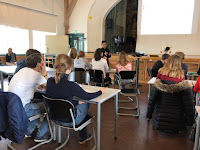Education in Japan (Natalie Collor)
In most places, the influenza virus is hard to avoid, even though many people receive a yearly vaccine to improve their odds of contracting the virus. Japan is no different, but its schools have measures in place to help prevent large-scale spreading of the virus.
One tactic most schools have in place is to ‘suspend’ students if the number of students with the virus is between 20% and 33% of the whole homeroom class. For three to five days, students are not allowed to come to school. Unlike the American use of ‘suspend,’ this action does not punish students or reflect badly on their academic record. They simply stay at home and do whatever homework they are able to without attending class and, for some, while managing sickness. In terms of the schoolwide spread of the virus, if just 10% of students in a specific grade to contract influenza, the whole grade will be suspended for a short period of time. Since the influenza virus is spread very easily through skin-to-skin contact, school administrators believe the best way to prevent mass spreading throughout schools is to suspend students in the given ways.
Although January and February are typically thought of as flu season, there were schools in Gunma Prefecture that announced the first cases of influenza spreading as early as November of 2017. There were several schools that suspended individual classes and whole grades, so flu season is already well underway in Japan.
While students may be quick to celebrate this guilt-free suspension which allows them to stay at home to rest, watch TV, or play video games, teachers are not as pleased when their students are suspended. They cannot move forward with the material according to the curriculum when all students are missing, therein making homework very repetitive. Teachers may appreciate having an extra break period or two, given the busy day-to-day workload, but the result of numerous cancelled classes due to the suspension puts them in a difficult position. The more students that are missing, the less teachers are actually able to accomplish during the school day. No matter how long the students are missing from school, they are expected to finish the standard curriculum for each subject by the end of the school year, which means teachers have to find ways to add in make-up classes and homework assignments. This situation reflects the snow day phenomenon in American schools, where students are happy to have time off in the winter, but unhappy to be making everything up during the dog days of summer.
 午後は、ウプサラで開催されるゾンビマラソンに参加しました。全5.5kmの道のりを、ゾンビに追いかけられながら走ります。走る人は、マジックテープでつけられた3本のテープを腰につけ、ゾンビに取られないように逃げます。ゾンビは本当にリアルで、真っ暗な林の中からうめき声をあげて出てくる時は、本当にびっくりしました。演出も素晴らしく、大人でもとても楽しめました。
午後は、ウプサラで開催されるゾンビマラソンに参加しました。全5.5kmの道のりを、ゾンビに追いかけられながら走ります。走る人は、マジックテープでつけられた3本のテープを腰につけ、ゾンビに取られないように逃げます。ゾンビは本当にリアルで、真っ暗な林の中からうめき声をあげて出てくる時は、本当にびっくりしました。演出も素晴らしく、大人でもとても楽しめました。 そして夜、恐怖の闇に包まれる時がやってきました。 ウプサラで初の試み、RUN FOR YOUR LIVESに参加してきました。街にあふれるゾンビたちをかわし5.5kmのコースを走り逃げる、ハラハラドキドキのおにごっこの始まりです!
そして夜、恐怖の闇に包まれる時がやってきました。 ウプサラで初の試み、RUN FOR YOUR LIVESに参加してきました。街にあふれるゾンビたちをかわし5.5kmのコースを走り逃げる、ハラハラドキドキのおにごっこの始まりです!









